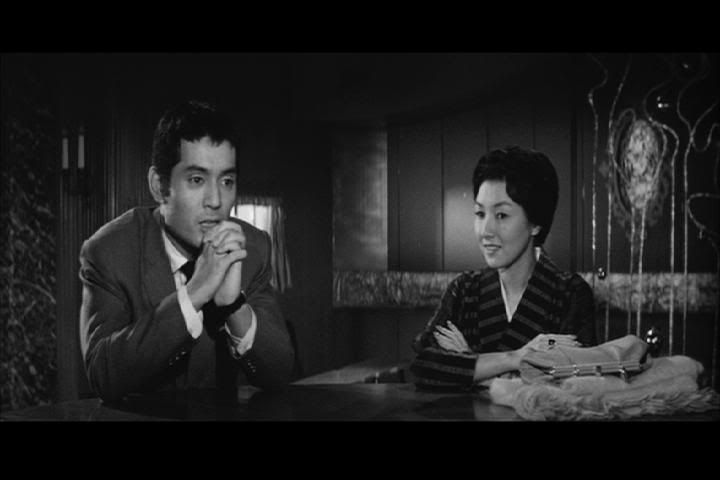
Mikio Naruse has undergone a bit of a resurgence in recent years, after long living in the shadows of more internationally famous directors and recognized auteurs like Ozu and Kurosawa. His style is not nearly as recognizable or pronounced as either of those directors, and his tendency towards the thematic material of "women's pictures" probably also contributed, unfortunately, to the lack of seriousness regarding his work. In his way, though, he's turned out to be every bit as distinctive and worthy of attention as his better-known peers. When a Woman Ascends the Stairs seems to be something of a change from Naruse, and it's certainly set off in several ways from the three films of his I've seen from the great UK DVD box set. For one thing, in the late 50s he expanded his canvas to a widescreen aspect ratio from the squared-off Academy ratio of the earlier films, and he makes full use of the long, narrow canvas for some very interesting compositions. This film also uses a much more expressive lighting palette, and the many interior scenes in bars are even reminiscent at times of film noir in their dynamic lighting and use of shadow. The effect is enhanced by the jazzy, jangly score, which would have seemed drastically out of place in the quiet, even-keeled worlds of the other Naruses I've seen.
But these are mostly cosmetic touches, and in many ways the departure from the earlier films is not as drastic as it might seem. The story of the widowed Ginza bar hostess Keiko (the lovely Hideko Takamine), the film certainly shares the same thematic territory that Naruse was continually returning to. The conditions, opportunities, and thoughts of women in post-war Japan were a continual source of material for him, and this film, like the others, uses the milieu of the Ginza bar to lightly probe into the social conditions that limit women's options in life. There is little overt social commentary in the film, but it is nearly impossible to view its narrative arc as anything other than a condemnation of the era's treatment of women. Naruse presents a society in which women are forced by circumstances, often male-imposed, in which they must lower themselves in order to survive, and are then judged harshly by those very same men. It's a vicious Catch-22, and one certainly related to the madonna-or-whore paradox that has so often dominated male-centric views of women.
The film also lays to rest any claims about Naruse's lack of style. What he has, in fact, is a near-invisible style, but a powerful one nevertheless. His camera positioning lacks the flair or symbolic heft that critics so love to point out in Ozu, and he doesn't have Kurosawa's flashy movement either. He imparts his stamp on his films, instead, through the editing, and by giving a crisp, rhythmic layout to his scenes that seems entirely natural until you really study it. I must confess that at first I found myself falling into the trap as well, admiring the story and the characterization but finding little of interest in the aesthetic content. But then there's scene about 40 minutes in where Keiko has a discussion with her manager Komatsu (Tatsuya Nakadai) about the possibility of opening her own bar, and I began to notice the astonishing but subtle way in which Naruse was breaking down the scene. His films are often filled with lengthy two-person conversations; these are the emotional core of his work and the area in which his stylistic prowess is most at work.
In this scene — and, I came to notice, in all the film's conversation scenes — Naruse cuts between striking close-ups and a series of two-shots that are constantly re-positioning the characters in space and in relationship to each other. Naruse's cutting is precise and economical, hitting each beat with perfect timing. Close-up; shot over Keiko's shoulder with Komatsu facing her; close-up; two-shot with Komatsu in the background and Keiko foregrounded; close-up; two-shot with the pair side by side at the bar. The precision of the cuts and the shifting perspectives — at one moment we seem to be on one end of the bar, then when the shot cuts back we've moved 180 degrees — serve to emphasize the importance that Naruse places on conversations and interaction. In another scene, towards the end, when Keiko's lover leaves her at her apartment, Naruse carefully refrains from showing much of the space in the room during their conversation, largely sticking to tight Cinemascope close-ups that locate their heads to one side of the frame, leaving long stretches of empty space. This restraint enhances the impact when, towards the very end of the scene, he finally reveals the pair standing together towards the center of the large room, which suddenly seems very sparse. Naruse also deliberately foregrounds the kitchen table, where the man leaves some stock certificates as a somewhat empty parting gift, and the white rectangle of paper serves as a sad reminder of his absence even after he leaves.
Obviously, Naruse's lack of style has been drastically overstated. This film, as with everything I've seen by him, is possessed of a quietly confident sense of composition and the rhythms of life, expressed in his carefully modulated editing. It's a simple, inconspicuous style, and when the narrative is working at its best, can be almost invisible. When a Woman Ascends the Stairs is a perfect encapsulation of Naruse's subtle style and light touch within a melodramatic narrative.

No comments:
Post a Comment